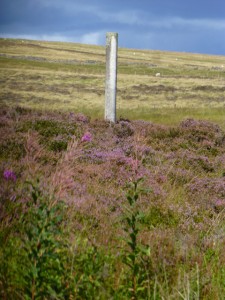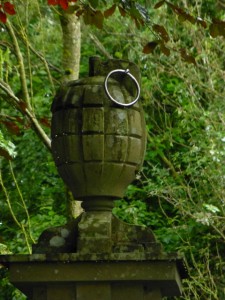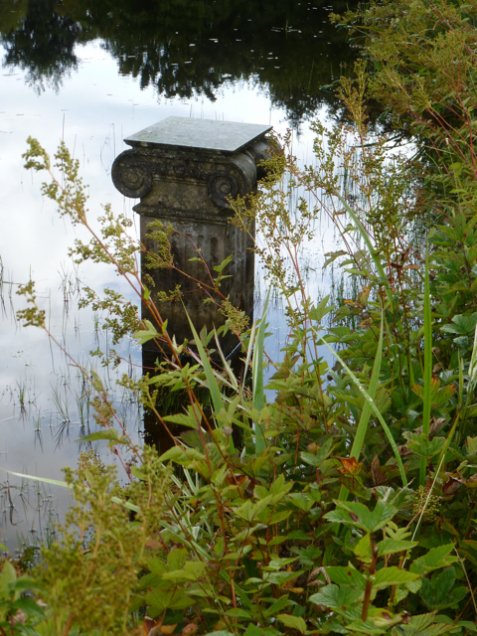 Standing in a white-walled contemporary gallery, I am looking at pieces of rock strung as a necklace. Inspected through the chained magnifying glass the mica glints in cool electric light. I have booked on line to take the bus from under the 20 foot high message “We don’t stay here Because of Gravity. We stay because we like it”. Half an hour to go and exhibits done to death, I move on to stare vacantly into an empty perspex box. “This object is currently orbiting the earth”.
Standing in a white-walled contemporary gallery, I am looking at pieces of rock strung as a necklace. Inspected through the chained magnifying glass the mica glints in cool electric light. I have booked on line to take the bus from under the 20 foot high message “We don’t stay here Because of Gravity. We stay because we like it”. Half an hour to go and exhibits done to death, I move on to stare vacantly into an empty perspex box. “This object is currently orbiting the earth”.  All aboard at last and out of festival-laden Edinburgh to South Lanarkshire. Our driver drops us at the bottom of the stone track with a laconic ”2 hours and I’’ll be leaving”. Time to stride out competitively in walking boots, sloshing through puddles of mud and sheep poo. The landscape is curvy with flocks grazing, hay baled and heather in quilt-patches. Ten minutes up the track Little Sparta hoves into sight: an oasis of trees resembling a hill-top sacred grove. This garden, made by Ian Hamilton Finlay has been on my wanted list for years. In under the wooden archway emblazoned “A Cottage - a Field - a Plough” I can see that it is going to be a wordy afternoon. Wielding camera, a feverish desire to squeeze all the juice out of the place is upon me. It is en exhausting way to start a visit and thanks to drills of stair-rod rain and a flattening camera battery, a slower pace is forced. It is deliberate that I have read nothing of Hamilton Finlay. A few slack writing months lie between that day and writing this up, during which I have had the comment from Anne Wareham: “we found it a little overstuffed”. Here are my impressions. The only preconceived one was that the garden would be pretentious. One step in, and that got blown away.
All aboard at last and out of festival-laden Edinburgh to South Lanarkshire. Our driver drops us at the bottom of the stone track with a laconic ”2 hours and I’’ll be leaving”. Time to stride out competitively in walking boots, sloshing through puddles of mud and sheep poo. The landscape is curvy with flocks grazing, hay baled and heather in quilt-patches. Ten minutes up the track Little Sparta hoves into sight: an oasis of trees resembling a hill-top sacred grove. This garden, made by Ian Hamilton Finlay has been on my wanted list for years. In under the wooden archway emblazoned “A Cottage - a Field - a Plough” I can see that it is going to be a wordy afternoon. Wielding camera, a feverish desire to squeeze all the juice out of the place is upon me. It is en exhausting way to start a visit and thanks to drills of stair-rod rain and a flattening camera battery, a slower pace is forced. It is deliberate that I have read nothing of Hamilton Finlay. A few slack writing months lie between that day and writing this up, during which I have had the comment from Anne Wareham: “we found it a little overstuffed”. Here are my impressions. The only preconceived one was that the garden would be pretentious. One step in, and that got blown away.  Little Sparta is a watery bosky place with the Pentland Hills wrapped round it in gentle creases. The water is peaty, fast and brown and has the rain drubbing down and making patterns on smooth surfaces, causing rushing rivulets in dammed and channeled streams. I tread with caution over stepping stones and the calligraphy begins in earnest: “Ripple in a fold. A fluting of the Liquid” Set in quivering peaty water. The words pour out of stone, brick and wood, fast and frequent. “Duck Dabbled Willow Swept Wind Scuffed Grass Girt Cloud Curved”. Alluring winding paths and jokes on stones lead me up the hill to a “STILE n. an escalation of the footpath” I climb it and tip out into the huge, cloud billowing view. Pulled out into the landscape where an obelisk, a circular grove and scattered inscribed giant rocks are a reminder that this is man made.
Little Sparta is a watery bosky place with the Pentland Hills wrapped round it in gentle creases. The water is peaty, fast and brown and has the rain drubbing down and making patterns on smooth surfaces, causing rushing rivulets in dammed and channeled streams. I tread with caution over stepping stones and the calligraphy begins in earnest: “Ripple in a fold. A fluting of the Liquid” Set in quivering peaty water. The words pour out of stone, brick and wood, fast and frequent. “Duck Dabbled Willow Swept Wind Scuffed Grass Girt Cloud Curved”. Alluring winding paths and jokes on stones lead me up the hill to a “STILE n. an escalation of the footpath” I climb it and tip out into the huge, cloud billowing view. Pulled out into the landscape where an obelisk, a circular grove and scattered inscribed giant rocks are a reminder that this is man made.  Several rain squalls later and in the lower half of the garden, bull and suckling herd can be seen close up, from under the washing line. They are framed by an old split oak that has been turned into a seat. The peat pond reflects the sky and has rosebay willow herb and scabious dancing round the edges. In amongst the rushes there is an artfully placed and semi-drowned rowing boat with a glinty new paint job and “Evermore” scribed in black on the bow.
Several rain squalls later and in the lower half of the garden, bull and suckling herd can be seen close up, from under the washing line. They are framed by an old split oak that has been turned into a seat. The peat pond reflects the sky and has rosebay willow herb and scabious dancing round the edges. In amongst the rushes there is an artfully placed and semi-drowned rowing boat with a glinty new paint job and “Evermore” scribed in black on the bow.  It is a secret inward looking place with references to the horror of war that pass me by at first but get ever more insistent - a pair of grenades on top of gate posts, anagrams of naval ships switched into wild flowers but dryads, sprites and classical references temper this. Stepping over a brick pathway with Virgil written over and over again a pair of hedges leads to a dead end. “In a lane one will not encounter Apollo. But one may come upon Pan”. Quite. Beyond there is an undulating lawn scribed with giant wave stones. I am a sucker for land art and I love the play on words The Seas Waves Sheaves. The dark echoes of the first world war close in as I follow a finger post “Zur Siegfried Linie” past the vegetable patch. Round the corner and outside the chapel I am brought up short by Apollo in a niche thrusting a machine gun skywards .
It is a secret inward looking place with references to the horror of war that pass me by at first but get ever more insistent - a pair of grenades on top of gate posts, anagrams of naval ships switched into wild flowers but dryads, sprites and classical references temper this. Stepping over a brick pathway with Virgil written over and over again a pair of hedges leads to a dead end. “In a lane one will not encounter Apollo. But one may come upon Pan”. Quite. Beyond there is an undulating lawn scribed with giant wave stones. I am a sucker for land art and I love the play on words The Seas Waves Sheaves. The dark echoes of the first world war close in as I follow a finger post “Zur Siegfried Linie” past the vegetable patch. Round the corner and outside the chapel I am brought up short by Apollo in a niche thrusting a machine gun skywards .  Is Little Sparta cluttered? is it all too much? Without a site map or a guide book, I cannot begin to guess how big the garden or what all these symbols mean so I will judge it by the effect it made on me. Mood was heightened by squalls of rain bursts and going round the garden in the opposite direction to my fellow minibusers. For love of nature and as addict of words (and secret would-be calligrapher), I was in awe of a space that was magical, mysterious and in harmony its setting. The reason that the site achieves this is through the planting. Sparse was the planting palette. There were enough astrantia to sink the Scharnhorst, rosebary willow herb to fill several aircraft hangers and the endless trunks of gnarly trees. This restraint in plant choice anchors and sets of Hamilton Finlay’s artworks and beds them into the giant horizon. As to these works - stepping stones, statues, fortezza columns and the rest, most of them made me laugh. HF is a master punner. A dry stone wall enclosure was simply labelled “Folding”. But others touched a sense of the dread of mortality and violence. Perhaps I got lucky going round the garden widdershins and got an up-beat feeling from leaching my gaze out to the hilly farmlands. Who knows. There was so much to take in and I would like to go back again and again. In sum I will go with the collapsed mossy column - symbolic in its own right - and the quotation from St Just “The World has been empty since the Romans”. Wonder what the ancient greeks would say to that.
Is Little Sparta cluttered? is it all too much? Without a site map or a guide book, I cannot begin to guess how big the garden or what all these symbols mean so I will judge it by the effect it made on me. Mood was heightened by squalls of rain bursts and going round the garden in the opposite direction to my fellow minibusers. For love of nature and as addict of words (and secret would-be calligrapher), I was in awe of a space that was magical, mysterious and in harmony its setting. The reason that the site achieves this is through the planting. Sparse was the planting palette. There were enough astrantia to sink the Scharnhorst, rosebary willow herb to fill several aircraft hangers and the endless trunks of gnarly trees. This restraint in plant choice anchors and sets of Hamilton Finlay’s artworks and beds them into the giant horizon. As to these works - stepping stones, statues, fortezza columns and the rest, most of them made me laugh. HF is a master punner. A dry stone wall enclosure was simply labelled “Folding”. But others touched a sense of the dread of mortality and violence. Perhaps I got lucky going round the garden widdershins and got an up-beat feeling from leaching my gaze out to the hilly farmlands. Who knows. There was so much to take in and I would like to go back again and again. In sum I will go with the collapsed mossy column - symbolic in its own right - and the quotation from St Just “The World has been empty since the Romans”. Wonder what the ancient greeks would say to that. 
